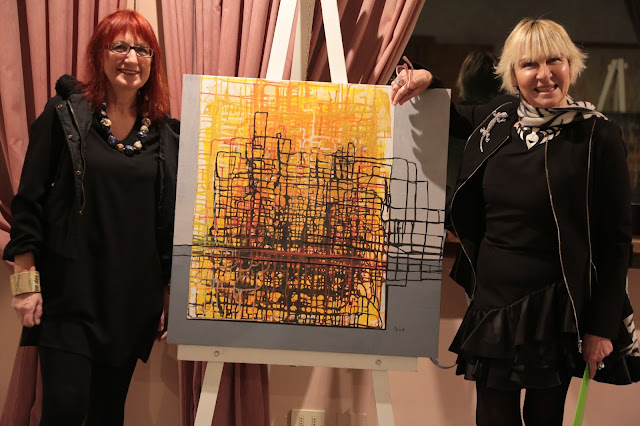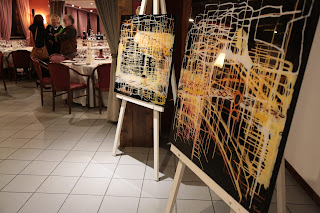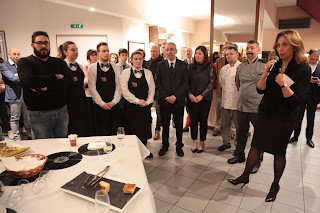Arnhild Kart è cresciuta a Düsseldorf, metropoli industriale sul Reno, i cui grattacieli hanno ispirato atmosfere e valori ritmici dei suoi lavori. La metropoli inumana e impersonale, assurta da un secolo a metafora della condizione esistenziale, è stata protagonista di bellissime tele di Arnhild, con luci e baluginii che fanno pensare alle piogge metafisiche dell'inferno dantesco o alle città del più tetro futuro fantascientifico come in Blade Runner. E sono quadri di struggente bellezza nella loro drammaticità, come pure commoventi sono i personaggi che lei costruisce, fragili saltimbanchi isolati che si arrampicano verso un cielo troppo lontano, oltre i grattacieli.
Col tempo quei muri e strade si sono andati scarnificando. Chi va nella cappella di San Severo a Napoli e, dopo essersi estasiato per le meravigliose sculture di marmo bianco, scende nel sotterraneo, vede quello che è la struttura vascolare indurita di un essere umano che solo ad essa è ridotto. Similmente, nei recenti quadri di Arnhild, i grattacieli sono diventati scheletri luminosi, fatti di filamenti di led che si incrociano ortogonalmente. Avvertiamo il senso metafisico di quelle strutture che sono entrate in noi come strutture di pensiero, articolazioni del senso dell'esistere.
Ci giunge così il messaggio di Arnhild come un canto di libertà, un richiamo alla ricerca del senso al di là degli schemi imposti.
Nei due quadrati neri tutta la tela è coperta da filamenti che non lasciano spazi vuoti né possibilità di dialettica. Il plexiglass dipinto dall'interno crea l'illusione dello spazio in cui scorrono le linee.
Nelle altre due tele quadrate invece restano aree che sembrano però precariamente libere con i filamenti neri che si allargano implacabili nelle aree grigie.
Le tele rettangolari bianche e nere sembrano percorse da segni accesi e intensi con richiami a doppie spirali che hanno un ritmo musicale, una struttura melodica a più voci che si intrecciano in un campo vuoto. Un senso di bellezza e di respiro ampio ne emana, una possibilità di libertà. Note di diverse altezze e durate, timbri gravi scuri o alti e chiari. Gialli e rossi accesi e neri profondi, i colori riscaldano di emozioni leggerezze tenui e asprezze tetre, rendendo alla vita le sue tante varianti, i sapori e i moti del cuore. I segni colorati si muovono come in canali il cui illusorio spessore è ottenuto anche qui dipingendo la striscia di plexiglass dal lato posteriore.
Nelle altre tele rettangolari lo sviluppo tortuoso dei colori di diverse tinte evoca lo spazio dinamico sia del mondo interiore umano che dell'universo, evidenziati nella parte centrale del dipinto. Negli altri settori della tela si coglie, come fuori fuoco, la stessa struttura di intrecci, il passato o il futuro di una storia in corso di svolgimento della quale l'uomo non siamo certi che sia attore responsabile con i suoi desideri ed emozioni a guidarlo o se subisca, come il resto dell'universo, un destino fatto di leggi che non dipendono da lui.
* * *
Freedom and Destiny
Recent works by Arnhild Kart
Arnhild Kart grew up in Düsseldorf, an industrial metropolis on the Rhine, whose skyscrapers inspired the atmosphere and rhythmic values of Arnhild's works. The inhuman and impersonal metropolis, risen for a century as a metaphor for the existential condition, has been the protagonist of beautiful paintings by Arnhild, with lights and glimmers that suggest the metaphysical rains of Dante's hell or the cities of the darkest future science fiction like in Blade Runner. And they are paintings of poignant beauty in their drama, as well as moving are the characters she builds, fragile isolated acrobats who climb to a sky too far beyond the skyscrapers.
Artist of great formal and technical rigor (in fact for many years she was the owner of a factory of design items creating perfect furnishings), she painted rigorous perspectives and geometries I would say pierfrancescane, a rational but unbalanced and unsettled urban landscape.
Over time, those walls and streets have been somehow defleshed. Whoever goes to the chapel of San Severo in Napoli and, after having become enraptured by the wonderful white marble sculptures, goes down to the basement, sees what is the hardened vascular structure of a human being who is only reduced to it. Similarly, in Arnhild's recent paintings, skyscrapers have become luminous skeletons, made of filaments of LEDs that cross orthogonally. We feel the metaphysical sense of those structures that have entered us as structures of thought, articulations of the sense of existence. Thus Arnhild's message reaches us as a song of freedom, a call to the search for meaning beyond the imposed patterns.
Continuing her research that digs the roots of living in the forms that thought takes, Arnhild has identified in the DNA the symbol in which to synthesize the processes that regulate and transform reality. In the new canvases we perceive something that seems to grow, flow autonomously, strands that seem to be alive and reproduce.
Arnhild's fantasy and brush pursue those paths with concern and emotion, along mysterious channels in which thought and reality try to meet.
The whole black square canvases are covered with filaments that leave no empty spaces or the possibility of dialectics. The plexiglass painted from the inside creates the illusion of a space in which the lines flow.
In the other two square canvases, however, areas remain that seem precariously free while the black filaments that invade relentlessly the gray areas.
The rectangular black and white canvases seem crossed by bright and intense signs with references to double spirals that have a musical rhythm, a melodic structure with several voices that intertwine in an empty field. A sense of beauty and wide breathing emanates from it, a possibility of freedom. Notes of different heights and durations, serious dark or high light tones. Bright yellows and reds and deep blacks, the colours warm up the patterns with emotions that have soft lightness and gloomy harshness, giving life its many variations, the flavors and motions of the heart. The coloured signs move as in channels whose illusory thickness is also obtained here by painting the plexiglass strip from the rear.
In the other rectangular canvases the tortuous development of the colours of different hues evokes the dynamic space of both the human inner world and the universe, highlighted in the central part of the painting. In the other areas of the canvas one catches the same weaving structure, as out of focus, the past or the future of a story in progress of which man is not sure if he is responsible actor with his desires and emotions to guide him or if, like the rest of the universe, he undergoes a fate made of laws that do not depend on him.
















